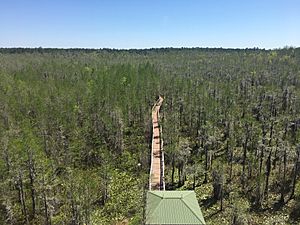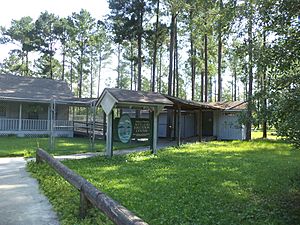Grand Bay (Georgia) facts for kids
Grand Bay is a huge, important swamp in Georgia. It covers about 13,000 acres (that's over 50 square kilometers!) across Lanier County and Lowndes County. This amazing natural area is made up of two main parts: the Grand Bay Wildlife Management Area, which is a special place for learning about nature, and Banks Lake National Wildlife Refuge, a beautiful lake where people can have fun and learn too.
Discovering Grand Bay's Wetlands
The Grand Bay Wetland Education Center is a fantastic place to explore and learn about wetlands. It's run by a team effort between the Coastal Plains Regional Educational Service Agency and the Georgia Department of Natural Resources. This center helps visitors understand why wetlands are so important for our planet.
What You Can Do at the Center
The Education Center has lots of cool features for visitors. You can walk along a special boardwalk that takes you right into the swamp, giving you a close-up view of the plants and animals. There are also classrooms for learning and a tall observation tower where you can see amazing views of the entire Grand Bay area.
The center offers many fun and educational programs. These include:
- Environmental education programs that teach you all about wetlands.
- Exciting field trips for school groups.
- Special training for teachers, so they can learn more about nature too.
Learning About Wetland Life
The main goal of the Grand Bay Wetland Education Center is to teach students about the connections between plants and animals. They focus on several interesting topics, such as:
- Wetland Ecology: This is the study of how living things interact with their wetland environment.
- Wildlife and Plant Identification: Learning to recognize the different animals and plants that live in the swamp.
- Air Quality: Understanding how wetlands help keep our air clean.
- Plant Adaptations: Discovering how wetland plants have special features that help them survive in wet conditions.
By visiting Grand Bay, you can learn so much about the natural world and why it's so important to protect these special places.



